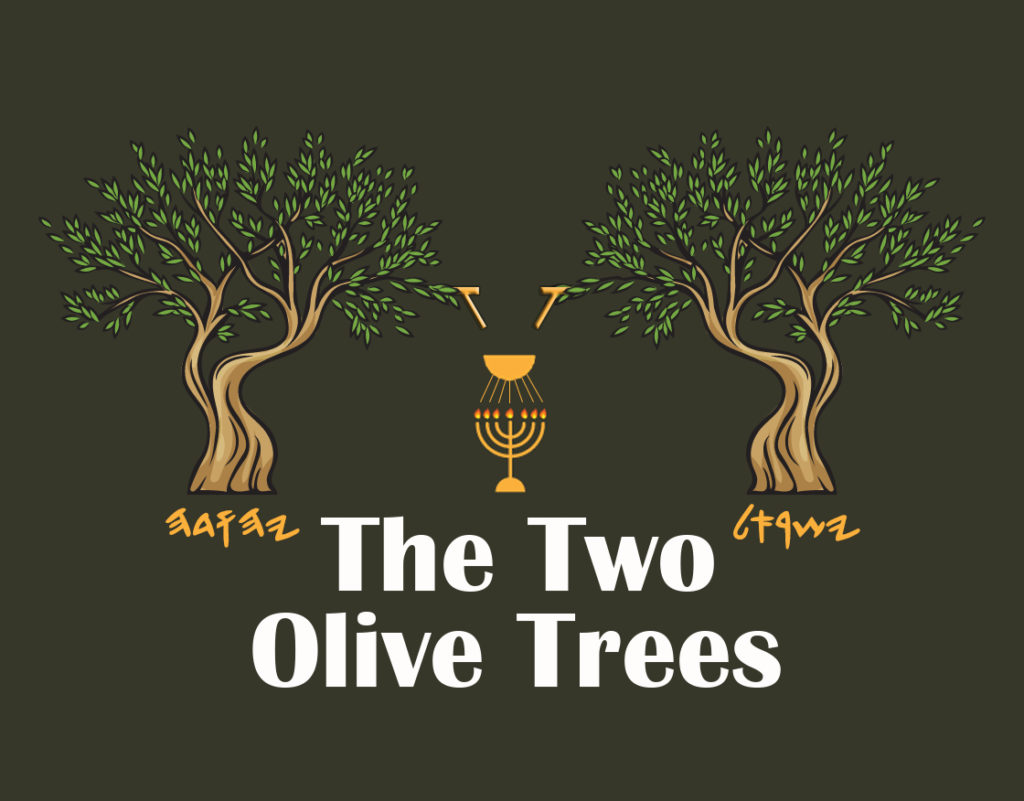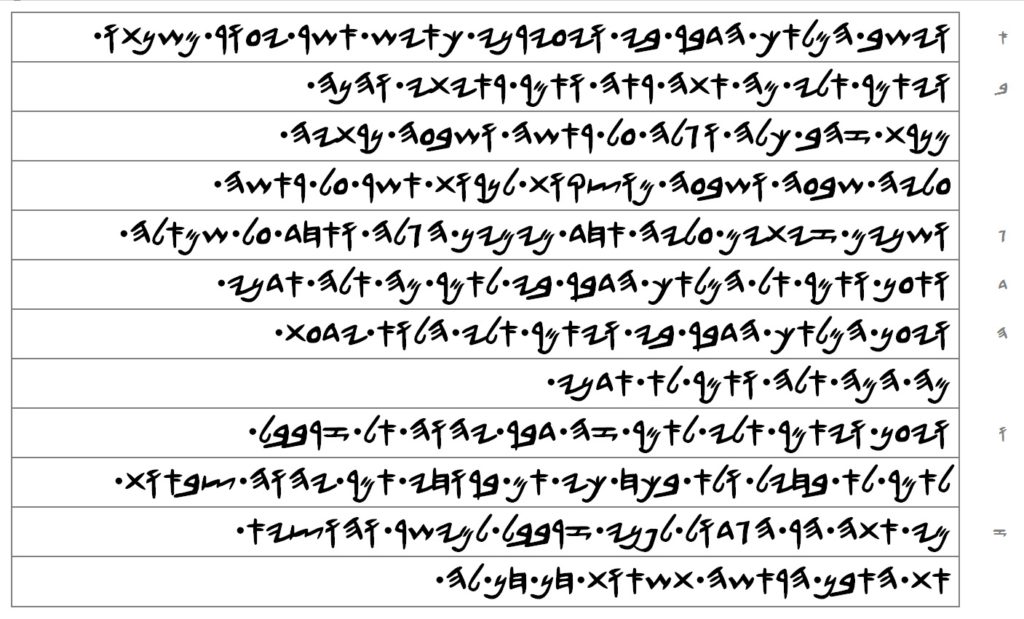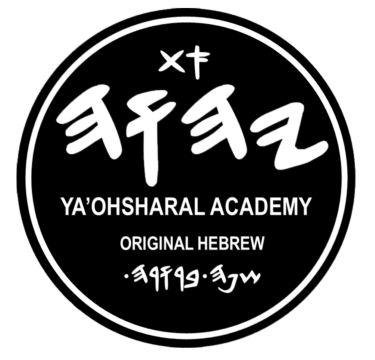

[1] And he returned, the messenger, the one speaking to me, and he stirred me up like as a man will be stirred up from his sleep.
[2] And he said to me: What do you see? And I said: I see, and behold, a manarah of gold all of it, and bowl fountain reservoir upon the top of it, and its seven candle branches upon it are seven, and seven tube castings to the candle branches, which is upon the top of it.
[3] And two olive trees beside it, one from the right of the bowl fountain reservoir, and one by the left of it.
[4] And I replied and said to the messenger, the one speaking to me, saying: What are these lord?
[5] And he answered, the messenger, the one speaking to me, and he said to me: Don’t you know what they are? And I said: No, lord.
[6] And he answered and he said to me saying: This is the word of YA’OH to Zar-babal saying: Not by force, and not by strength, but though my breath, says YA’OH tsaba’oth.
[7] Who are you, great mountain, before Zar-babal? For a flat plain! And he will bring forth the stone, the head, with shout cries – Grace! Grace! – unto it.
COMMENTARY OF ZACHAR-YA’OH 4:2-7
[2] The prophet said that he saw a manarah (‘seven-branched candelabrum’) all made of gold and readers of his book knew immediately what this looks like. Yet the manarah he described was attended by objects that did not attend the manarah Mashah was commanded to make for the wilderness tabernacle (Thorah 2:31-40; 27:20-21; Thorah 3.24:1-3). The prophet saw a manarah with a galah (‘bowl fountain reservoir’) suspended over the top of it and there were seven motsakoth (‘tube castings’) to feed the seven candle branches of the manarah below it. The manarah of the wilderness tabernacle did not have such an apparatus suspended over it.
[3] There was also an olive tree on each side of the galah. The olive trees supply the oil needed to light the manarah.
[4] The prophet is curious about what he sees and asks the messenger to tell him what they are.
[5] The messenger acts surprised that the prophet does not know what they signify.
[6] The messenger replies that the vision is the word of YA’OH unto the governor Zar-babal, the leader of the exile community that left Babylon. Zar-babal was attempting to rebuild of the temple in Yaroshalam, but opposition incentivized by the indifference of Cyrus the Great to compel compliance of his decree (Ghazar’a [Ezra] 4:5) stood in the way and prevented Zar-babal from getting the job done. He must have entertained thoughts that the only way to build the second temple was by raising an army and resorting to armed force.
Now in the vision, the galah (‘bowl fountain reservoir’) with its seven motsakoth (‘tube castings’) suspended over the manarah are what supply the manarah with the oil that each of the seven candle branches need in order to be lit, and the two olive trees on each side of the galah are what supply the galah with its oil.
The message is clear. Zar-babal, the man who was over the entire exile community, will be given what he needs to complete the buildin of the second temple. These two olive trees represent the people of Ya’oh-shar-al in their two main divisions: the house of Ya’ohdah (one tribe) and the house of Ya’oh-shar-al (eleven tribes). See Yaram-Ya’oh (Jeremiah) 11:16 for the olive tree being a name for the people of Ya’oh-shar-al. The brotherhood of Ya’ohdah and Ya’oh-shar-al (1 Kings 4:20) was broken in the days of Yarab-gham I (Jeroboam I) after he revolted from Shalamah (1 Kings 11:31-32), but the unity was re-established in the time of Zar-babal during the return of all the tribes from exile in the 6th century (Yashai-Ya’oh 11:13). The brotherhood between the two main divisions of the nation was broken again in the first century in the days leading up to the great war with Rome (Zachar-Ya’oh 11:14).
YA’OH was telling Zar-babal by this vision that He will inspire and strengthen the people of Ya’ohdah and Ya’oh-shar-al, the two olive trees, and they will step up and put their hands to the work of the restoration and assist Zar-babal. He will not need a militia of men armed with swords in order to complete the task.
[7] The obstacles Zar-babal faced seemed insurmountable, impossible for him to overcome. They were a great mountain standing in his way. Yet they became as a flat plain as a result of the rokh (‘wind/breath/force’) of YA’OH.

[8] And it came to pass, the word of YA’OH was unto me, saying:
[9] The hands of Zar-babal laid foundation of this house, and his hands will finish it. And you will know that YA’OH tsaba’oth, He sent me unto you all.
[10] For who has despised to the day of small things? And they will rejoice, and they will see the stone of the plumb line in the hand of Zar-babal. These seven are the eyes of YA’OH. They run to and fro in all the earth.
COMMENTARY OF ZACHAR-YA’OH 4:9-10
[9] Zar-babal not only finished laying the foundation of the temple he also finished building the temple upon the foundation he laid. He finished it the temple edifice in the days of King Daray’osh Hystaspes (509-473 BCE), very late in the 6th year of that king’s reign (Ghazar’a [Ezra] 6:15), which was the winter of 503 BCE.
[10] The second temple Zar-babal built was smaller and less grandiose than the first temple Shalamah built. Some of the elders who saw the first temple before its destruction in 586 BCE were not impressed when they saw the foundation of the second temple being laid (Ghazar’a [Ezra] 3:12). Other elders shouted for joy because despite it being “the day of small things,” it was still a major step forward, and evidence of the grace shown to them by YA’OH after He had punished them by the destruction of the first temple and exile. The Babylonians who destroyed the first temple were never going to allow it to be rebuilt, and it never would have been rebuilt if YA’OH had not taken down the Babylonian regime and given the throne of Babylon to the kings of Persia.
The plumb line (a string with a stone weight tied at one end) was used by builders to determine the perpendicularity of a structure. You didn’t need one unless you were actually erecting a building. So for people to see one in the hand of Zar-babal meant that he received the green light to begin building and he was building. It was a reason for rejoicing.
We read in scripture that the eyes of YA’OH run to and fro in the earth searching and scanning for the man whom YA’OH will strengthen Himself with because that man’s heart is perfect towards YA’OH (2 Chronicles 16:9). His eyes were at that time with Zar-babal and this is why Zar-babal was successful.

[11] And I answered and said to him: What of these two olive trees by the right of the manarah and by the left of it?
[12] And I answered a second time and said to him: What of the two branches of the olive trees which by the hand of the two pipes of gold are the ones emptying the gold from out of themselves?
[13] And he said to me saying: Don’t you know what these are? And I said: No, lord.
[14] And he said: These are the two children of fresh oil, the ones standing by the Lord of the whole earth.
COMMENTARY OF ZACHAR-YA’OH 4:11-14
[11] The prophet wants to know the meaning of the two olive trees. We have already answered this question for him above, but the messenger is about to confirm that our answer is correct.
[12] The prophet’s second question is a request for more detail about the olive trees because each tree has a branch with a golden pipe sticking out of it, and gold is emptied from each golden pipe. We know that the oil needed to light the manarah comes from the olive trees, but the two golden pipes in the two olive branches do not extract oil from the tree. They extract gold! This shows practical knowledge. Oil cannot be extracted from a tree the way tree sap is harvested from a tree using a spile. Tree oil is extracted by pressing oil-bearing olives, or oil-bearing seeds, or oil-bearing nuts. Hence, the vision of the two olive branches with two golden pipes can only mean one thing: the nation of Ya’oh-shar-al, which the two olive trees represent, becomes wealthy; so wealthy it empties gold from itself.
Therefore, the two olive trees are not two single individuals. They are two groups of people who are blessed to become obscenely rich in gold. They empty their gold because Zar-babal will use the gold to build the second temple.
[13] The messenger again acts surprised that the prophet does not know what the two olive trees and the two olive branches with the two golden pipes represent.
[14] The answer is given. The two olive trees are shanay banay ha-yatsahr (‘two children of fresh oil’). They are the righteous and freshly made few from the two main divisions of the nation, Ya’ohdah (one tribe) and Ya’oh-shar-al (eleven tribes). Old, rancid olive oil tastes bitter, stale, or sour and lacks the peppery, sharp taste of fresh new olive oil. The two groups of people who merit being able to stand by the Lord of the whole earth must be fresh olive oil in His sight. Although the nation of Ya’oh-shar-al is as numerous as the sand of the sea, only a remnant make the cut and qualify as fresh new olive oil.
The vision of the two olive trees tells a beautiful true story of how remnants of all twelve tribes of Ya’oh-shar-al left the lands of their exile and returned to the promised land to restore their destroyed nation in the 6th century BCE. Their leader was the man Zar-babal, and his first order of business was building the house of YA’OH. He had a decree from Cyrus of Persia authorizing him to build the temple, but Cyrus went back on his word and allowed the enemies of our people to prevent Zar-babal from building (Ghazar’a [Ezra] 4:5). The people began to despair and they questioned whether it was really time to build. YA’OH sent His prophets to stir Zar-babal and all the people up so that they would not quit but rally themselves and resume building (Khag-Ya’oh [Haggai] 1:14). When all was said and done a new house of YA’OH was indeed built. The people pulled themselves together and threw their full support behind the man who was their leader. Despite huge obstacles the restoration of Yaroshalam was completed by the man who initiated it because the seven eyes of YA’OH were on him.
There is another book of prophecy that talks about the two olive trees of Zachar-Ya’oh 4:1-14. It is one that has been edited and interpolated by heathen Christian hands who made a corrupt Greek translation of it in the late 90s CE, but it was originally composed in Ghabaray (Hebrew) by an Abayon (Ebionite) in the year 44 CE. You have to know what Zachar-Ya’oh 4:1-14 is saying in all of its detail correctly in order to understand the message being conveyed in this much later prophetic book. Below I give an English translation of the restored text of Khazon (aka Revelation) chapter 11, verses 3 to 10.
[3] And I will give to my two witnesses and they will prophesy for 1,260 days, and they are clothed in sackcloth.
[4] These are the two olive trees by the manarah, the ones who stand by the Lord of the whole earth.
[5] And if a man will seek to harm them, fire goes forth from their mouth and consumes their enemies. And thus, all who seek to harm them will surely die.
[6] And to them there is power in their hand to shut up heaven, and it will not rain in the days of their prophesy, and they will smite the waters to change them to blood, and upon the earth to strike it with all plagues as often as they wish.
[7] When they have finished their testimony, the beast, the one coming up from the abyss, it will make war with them, and prevail against them, and kill them.
[8] And their corpses will be in the street of the great city, the one called Sadam.
[9] And many from the nations, and families, and languages, and peoples will see their corpses for three and a half days, and they will not give to put their dead bodies into graves.
[10] And they will rejoice over them, the inhabitants of the earth, and make party, and they will send gifts to one another; for these two witnesses tormented the inhabitants of the earth.
COMMENTARY OF KHAZON 11:3-10
This book was not written for heathen Christian idolators but heathen Christians idolators have had a version of it in their possession since the 90s CE and have mishandled it. This is why none of them until this day understand what the book is saying, because they have altered the text in places in order to insert their idol Christ god.
[3-4] The two witnesses are the two olive trees, and the two olive trees are, as we have already seen, the righteous and freshly made few from the two main divisions of the nation, Ya’ohdah (one tribe) and Ya’oh-shar-al (eleven tribes). They are the redeemed who make an Exodus from the lands of their captivity in the west where the slave ships brought their ancestors during the transatlantic slave trade and they go to the wilderness archipelago in the far east where the name YA’OH is being proclaimed by a ravenous bird. They remain in the wilderness for a symbolic period of 1,260 days which is a time, times, and a half amounting to ninety-eight years.
[5] The days of being able to harm the people of YA’OH will be over. Anyone who tries during the days of their testimony in the wilderness will die.
[6] The catastrophic natural disasters and cosmic disturbances that I have been talking about in several blog posts are the wonders to be caused by the remnant community in the wilderness. They are the destroyers of Babylon, and of Adom, and of the whole world, because YA’OH will put the power of nature into their hands during their time in the wilderness. The awesome destructive forces of weather and natural phenomena will dance to the beat of their drum (Yashai-Ya’oh 31:32). Their prophet will shake his hand upon their enemies and their enemies will become a spoil (Zachar-Ya’oh 2:9). If not then YA’OH has not spoken by me.
[7-10] When they finish their testimony in the wilderness they will return to reclaim the promised land, repossessing it from the heathens who occupy it. This will be the start of the final week of Danay’al’s 70 weeks prophecy. In the middle of that week Gog will put a stop to our sacrifices at the holy place and set up the abomination of desolation. This will trigger the greatest war of all human existence on earth, but the people of YA’OH will prevail at the end of the week (three and a half days = years later) and the desolator from the north will be destroyed. The heathen’s premature victory dance upon our dead bodies will end abruptly. YA’OH Himself will come to seal their doom and our dead bodies will be raised to life again.
There is much more I can say, much more to be disclosed, but this is enough to give you an idea of what the near future holds. I know all of this because the one who has me proclaiming His name in the east is my Mabayn (‘teacher’).
His name is YA’OH
Always has been. Always will be.
#EXODUS2023
1.15.7252 (April 5, 2023)

SHALOM AKH RAVENOUS I’m always appreciated of the outstanding information our HEAVENLY FATHER YA’OH MABAYN of MABAYNS has bestowed upon you so that you can regurgitated back to us YA’OHDAH. It seems like every time I’m searching navigating for more OVERSTANDING of Scriptural, Historical, Biblical Knowledge and wisdom or of lively hood in general there you are with a full bucket of Nutritionals Fruits. You are an TOB MA’AD MABAYN too AKH’AY RAVENOUS YA’OHDAH BAN DOR. Gotta go study to show myself approved SHALOM.
Don’t speak about what I go threw but as I start to read YA OH showed me already, it’s like I knew it before I even started to read it, I knew it was about the ravenous bird being used by YA OH to wake us up and this is proof to many that YA OH uses the pure at heart to complete what he needs to complete CHABOD L YA OH WA SHALOM KHAZAK LA CHA AKHAY
CHAL CHABOD LA-YA’OH GHALAYON!!! This is an insightful and enormous breakdown. May YA’OH our Redeemer continue to bless you with understanding and discernment. Shalom
HALALO ATH YA’OH! Thank you for this. With each article the prophecies become clearer to me… mainly the actual lengths of time. I will continue to study.